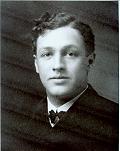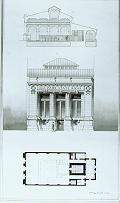 |
firm active: 1907-1921 minneapolis, minnesota :: chicago, illinois |
Biographical Notes: William Gray Purcell (1880-1965)
Biographical essay in Guide to the
William Gray Purcell Papers.
Copyright by Mark Hammons, 1985.
CORNELL, 1899-1903
 Portrait of
William Gray Purcell, circa 1900
Portrait of
William Gray Purcell, circa 1900
Although Purcell left for the College of Architecture at the Ithaca, New York, campus of Cornell University with high hopes, his experiences there were less exciting than anticipated. He packed along many personal memorabilia, since this was the first time he had ever lived away from home. His room in a plain but comfortable boarding house was filled with guns and animal skins from Island Lake and souvenirs from his graduation from Oak Park High School. Purcell also brought a variety of musical instruments, several cameras, and an eagerness to get on with the education that would enable him to practice as a professional architect.
 Study for Oak
Park State Bank, 1901
Study for Oak
Park State Bank, 1901
Unfortunately for his enthusiasm, he soon found himself bored with the
curriculum. The kind of architecture being taught at Cornell had little to do
with the exciting buildings Purcell had seen being built in the Midwest.
Although Cornell possessed a reputation as one of the newest and most advanced
universities in the country, Purcell found himself spending long hours over
drafting boards drawing Neo-classical designs based on Greek and Roman examples.
His teachers thought lightly, if at all, of the buildings that had inspired him
back in Chicago. Instead, the curriculum taught him traditional Beaux Arts composition.
Purcell had a hard time discussing the organic philosophy that fascinated him,
and found that the books he wanted to read, such as those of John Ruskin, were
not to be found in the library.
Purcell made as good a time as possible of his college years by participating in
numerous extra curricular activities. During his freshman year, he ran in track
events and was proud of tying a world's record. In his sophomore and junior
years he joined the campus Masque Players and Glee Club, as well as cultivated
his sketching technique. He frequently attended concerts, recitals, and other
entertainments, often in the company of his new friend, classmate George Feick,
Jr. All the tickets and programs, handbills and other memorabilia of these
attractions, together with many photographs Purcell took of the Cornell campus
and vicinity, were carefully collected and pasted in a large scrapbook.
In the summer of 1901, Purcell received his first opportunity to do professional
work in the architectural field. His grandfather had traveled through the South
during 1898 and was appalled by the poverty he had witnessed there. In Kowaliga,
Alabama, Gray met William E. Benson, a black man whose industry had enabled him
to triumph over the oppression of the sharecropper economic system. The editor
wrote an article about the Alabaman for The Interior, and subsequently
stayed in touch. When Benson said he wanted to use his money to build a new
community for a group of poor families, Gray suggested that his grandson, who
was studying to be an architect, was likely to have some useful ideas. Benson
wrote to Purcell, and arranged to have him come to Kowaliga.
The first week of his visit, Purcell surveyed the land and discussed the
requirements of the project with William Benson and his employees. He produced a
sketches for a number of simple wooden frame dwellings, and suggested an
arrangement for a small store and other community services. Halfway through his
stay, however, the work was interrupted by an incident of racial violence. Many
poor white people in the county where Benson lived were jealous of his land and
possessions. During one hot summer night a lynching occurred nearby and shortly
afterwards the mob appeared at Benson's door. Benson cautioned Purcell to remain
inside and out of sight, for the vigilantes milling about might take action
against a white man found staying with blacks.
Although Purcell returned to Cornell filled with ideas for the development,
Benson continued to be uncertain of what he ought to do. Correspondence and
sketches were exchanged for several months, but eventually nothing was realized
of the prototype community. Despite the lack of practical results, Purcell
decided to call the trip his first professional consultation, for which he
received payment of fifty dollars.
During his third year of studies, Purcell entered the Andrew D. White
Competition of 1902, sponsored and judged by the American ambassador to Germany.
The design that he submitted was laughed at by others preparing their own
entries, for the drawings featured no classical ornament and the plan was
strictly organized according to the minimal requirements of the program. To the
astonishment of his faculty and classmates, Purcell distinguished himself by
winning first prize.
Shortly after his triumph at the School of Architecture Purcell undertook the
sad task of designing a monument stone for his grandfather, who died in 1901. W.
C. Gray had served as the official photographer of the Third Alaskan Reindeer
Expedition of 1899 that sailed on the U.S.S. Revenue Cutter Bear. The cramped
conditions on board the ship and the arduous, lengthy journey weakened the
health of the seventy year old man, who had to leave the company part way
through the voyage. Gray never fully recovered from the arduous effort of the
trip, although his enthusiastic descriptions and large collection of photographs
convinced his son in law to take William and Ralph Purcell to Alaska in 1900.
The straightforward, unadorned design of the Memorial Stone for W. C. Gray was
in sharp contrast to the typically ornate funerary monuments of the time, and
next to the monument was placed a a pine tree transplanted from Island Lake.
The last year of his attendance at Cornell was uneventful, and Purcell graduated
in the spring of 1903. Catherine Gray came to the commencement with her
companion Annie Zeigler [5], who had agreed to remain with W. C. Gray's widow at
his dying request and would do so for the next thirty years. Once the ceremony
was over Purcell packed his scrapbooks and diploma, bade goodbye to his
roommates, and returned to Chicago ready to find an architect with whom he could
apprentice.
APPRENTICESHIP, 1903-1906